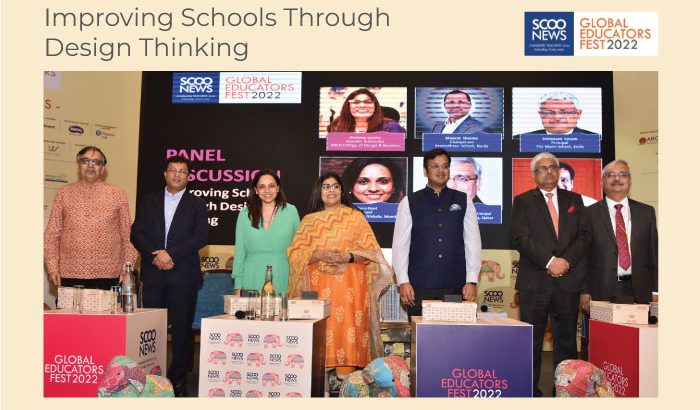In the fourth edition of the Global Educators Fest 2022, the theme Transforming School Curriculum: Empowering Learning for Life included various panels with leaders from the industry. In one such panel, Ms. Archana Surana, Founder and Director, ARCH College of Design & Business was invited to moderate a session on Improving Schools Through Design Thinking.
The other PANELISTS were:
Mukesh Sharma, Chairperson of Prometheus School, Noida
Srinivasan Sriram, Principal, The Mann School, New Delhi
Mahera Goel, Principal, Fazlani L’academie Globale, Mumbai
Harish Sanduja, Academic Doctor & Principal Birla Public School, Doha, Qatar
Shreevats Jaipuria, Vice-Chairman, Seth M.R. Jaipuria Group of Schools
Archana Surana started by explaining the importance of design in education. “Design creates culture, culture creates values and values determine the future. In today’s world of abductive thinking, design means different for everyone. For some, it is creative arts. For some, it is technology or services, or products. science or visual arts, or performing arts, or media, or fashion, or architecture. And that is the total notion of the creative industry. As Ken Robinson said, creativity is as important as literacy,” she said.
Shreevats Jaipuria said, “Design is not limited to creative people, it is for everyone Jaipuria has a framework that includes SPICE Sustainability Possibility, Integrity Collaboration, and Empathy Either in the same order or reversed it is the basic aspect taken into consideration to create a proper designing culture in the school education system”
Srinivasan Sriram said, “Design is a mindset, Currently communication is a very important skill to have. When we communicate, we need good language to do that. And design-thinking in the language is an important aspect one needs to look at. Quoting Don Norman’s method of design, he said. “We must empathize and understand the needs and nature of the learner before providing the solution. We must understand the root cause and d answer Whys. Here, solve the problem and not create a solution. Define the problem first. Take a Holistic Approach to design a system. Video tutorials, dip classrooms, role plays, prototyping and testing, and many more ways that your imagination can evolve. Lastly, don’t rush to the solution but take it to step by step Reflect upon, review, and redo the process until you get the required goal. In the whole process, holistic thinking is important.”
Mahera Goel added to the discussion by asking a question to the educators, “How do you foresee entrepreneurs that you are sending out in the VUCA world volatile, uncertain, complex, and ambiguous world? If we have to prepare the students for the real world they have to work in the real world When we cooperate we can get things done but, when we collaborate we can get innovation done Lives of the children will develop in a far better mats
Talking about entrepreneurs, Mukesh Sharma said. “We chose to follow IB because design thinking is a part of our curriculum. It allows even primary school children to identify problem areas that they can solve, whether It is with the help of technology or cognitive thinking.”
Harish Sanduja shared a curriculum that he has been working on. He said, “We have come up with a curriculum. The first part of it is for grades 6, 7, and 8. It is available on the CBSE website as well. It is an 18-hour curriculum that can be done as a club also. It includes three hours of introduction, three hours of transition and photography, and three hours of interaction and sketching, including many more that can also work to achieve the UN Sustainable Development Goals.”
It was concluded that a culture of learning should be developed for students as well as the teachers too. Technology, creativity culture, design thinking, and assessment all are part of holistic education in design thinking for all students for their all-around development
